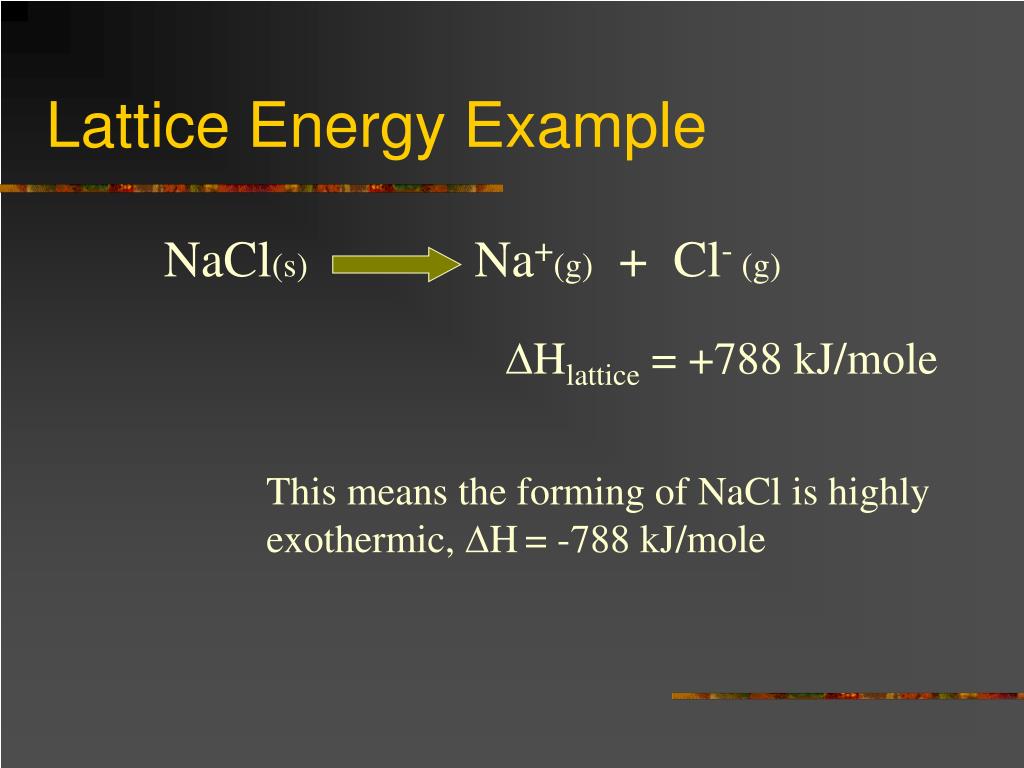

This effect is illustrated in Figure 4.2.2, which shows that lattice energy decreases for the series LiX, NaX, and KX as the radius of X − increases. For example, the calculated value of U for NaF is 910 kJ/mol, whereas U for MgO (containing Mg 2 + and O 2− ions) is 3795 kJ/mol.īecause lattice energy is inversely related to the internuclear distance, it is also inversely proportional to the size of the ions. Source: Data from CRC Handbook of Chemistry and Physics (2004).īecause the lattice energy depends on the product of the charges of the ions, a salt having a metal cation with a +2 charge (M 2 +) and a nonmetal anion with a −2 charge (X 2−) will have a lattice energy four times greater than one with M + and X −, assuming the ions are of comparable size (and have similar internuclear distances). Energies of this magnitude can be decisive in determining the chemistry of the elements. Representative values for calculated lattice energies, which range from about 600 to 10,000 kJ/mol, are listed in Table 4.2.1. The value of the constant k′ depends on the specific arrangement of ions in the solid lattice and their valence electron configurations, topics that will be discussed in more detail in the second semester. We see from Equation 4.4 that lattice energy is directly related to the product of the ion charges and inversely related to the internuclear distance. As before, Q 1 and Q 2 are the charges on the ions and r 0 is the internuclear distance. U, which is always a positive number, represents the amount of energy required to dissociate 1 mol of an ionic solid into the gaseous ions. #DeltaH_"lattice" -= -|DeltaH_"lattice"|# Do you mean the energy involved in the process to form #"NaCl"(s)# in its formation reaction? Well, to form the lattice, we have to get to the ions in their gaseous state and then allow sodium to transfer its electron over to chlorine.\) Where all the numbers you plug in to the righthand side are positive.įormation reactions generate #"1 mol"# of the product, such as #"NaCl"(s)#, from the individual elements ( #"Na"#, #"Cl"#) in their elemental state at "C"# and standard pressure.

Note that there exists a negatively-signed lattice energy for the following reaction: Chlorine is a diatomic gas at room temperature and pressure.Sodium is a metal at room temperature and pressure.(You should check your textbook to see whether it is defined as #"1 atm"# or #"1 bar"#.)Įlemental state simply means the natural state you find them at typical life conditions. These share the same product, so let's say we wanted to form the following cycle: Since forming the lattice stabilizes the components (we went from two gases to one solid, creating order), decreasing their overall energy. This would be what we call the Born-Haber thermodynamic cycle.

Our goal is to fill in the missing steps by transforming each element one step at a time (phases, charges, and chemical bonds): This is allowed since enthalpy is a state function, which does not depend on the path.Īs it turns out, the lattice energy is difficult to acquire in real life, so it is often indirectly obtained from calculations not unlike the ones we're doing. Then, the following reactions would be involved to transform each reactant for the formation of #bb("1 mol")# of #"NaCl"(s)# (the units therefore become #ulul"kJ"#!): #1/2"Cl"_2(g) stackrel(1/2xx"Bond-Breaking")overbrace(->) "Cl"(g) stackrel("1st Electron Affinity")overbrace(->) "Cl"^(-)(g)#įor simplicity in our Born-Haber cycle, let up use positive numbers and down use negative numbers.


 0 kommentar(er)
0 kommentar(er)
